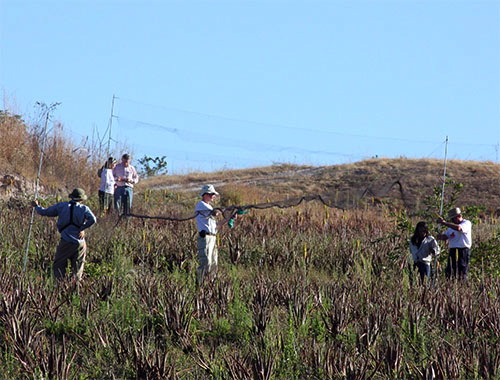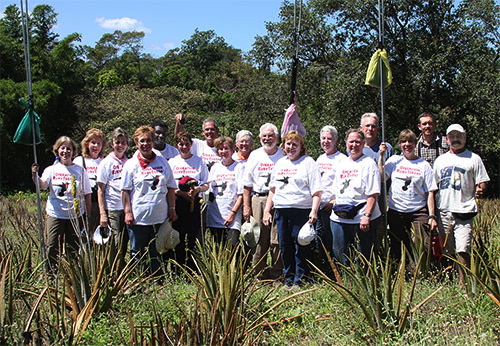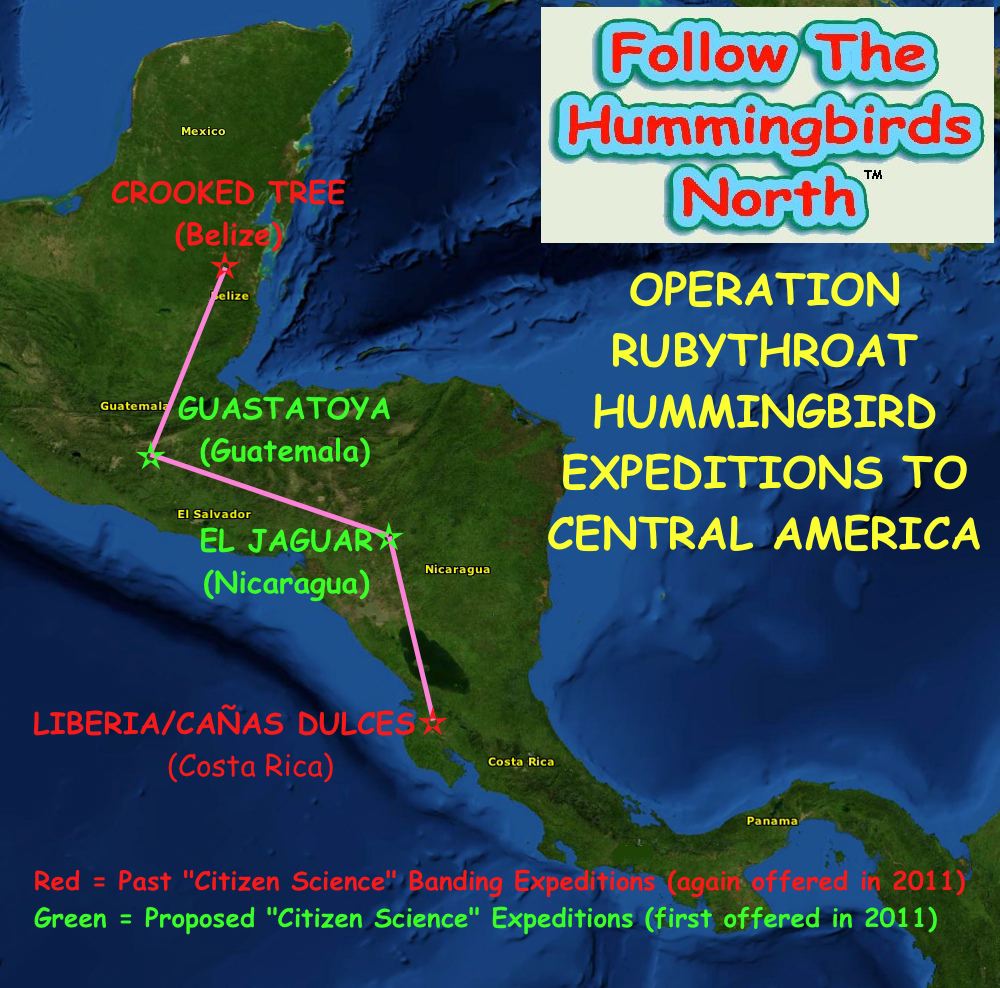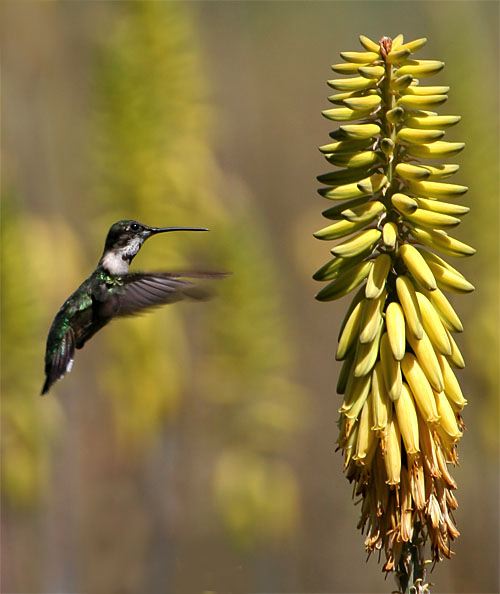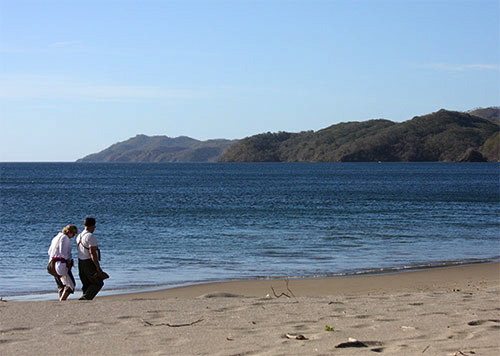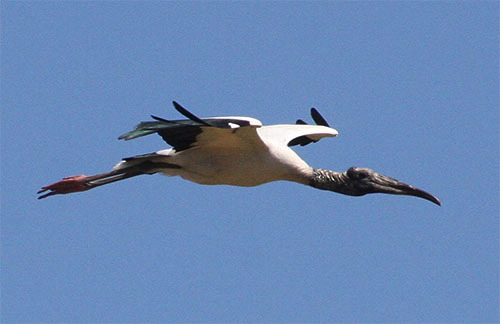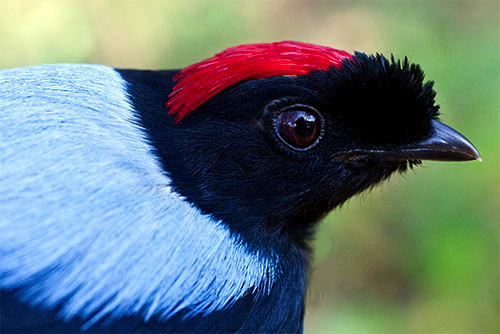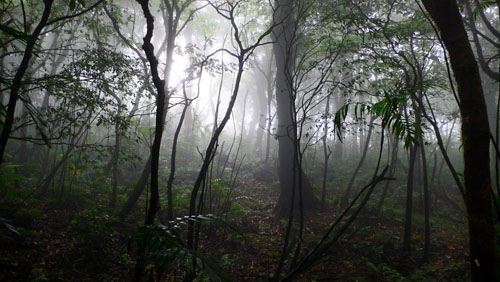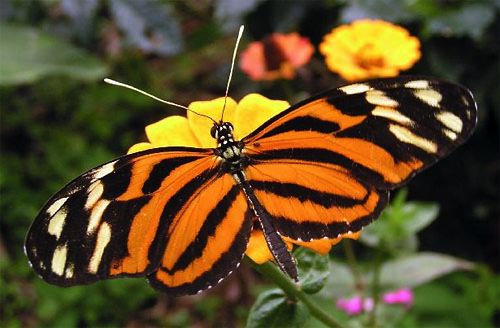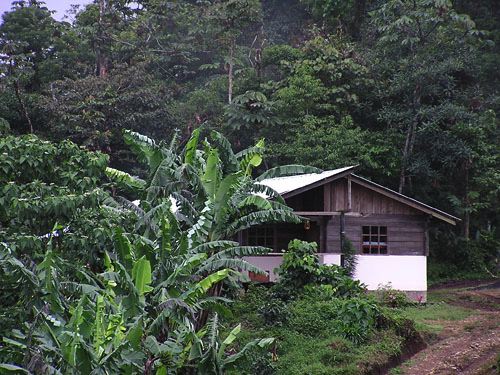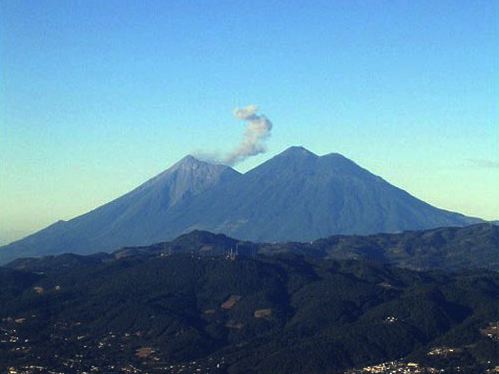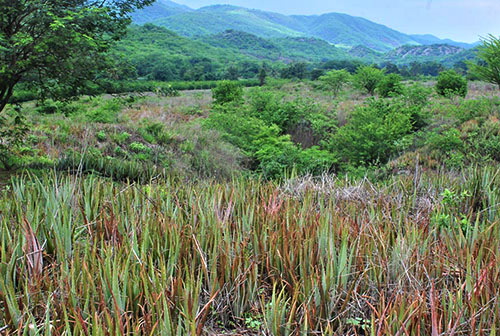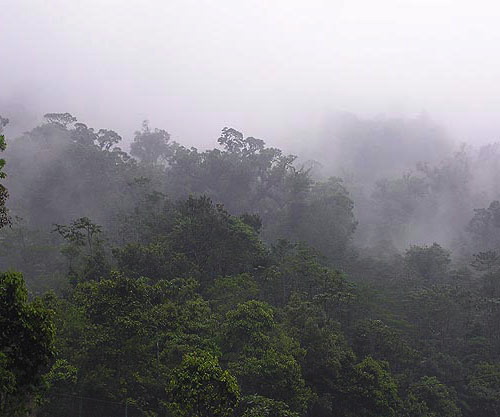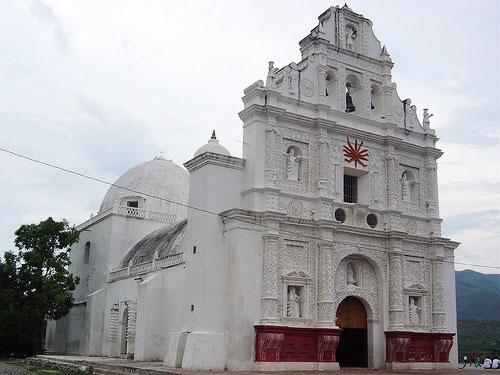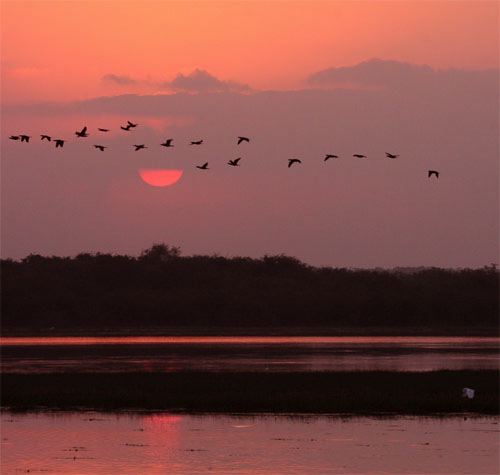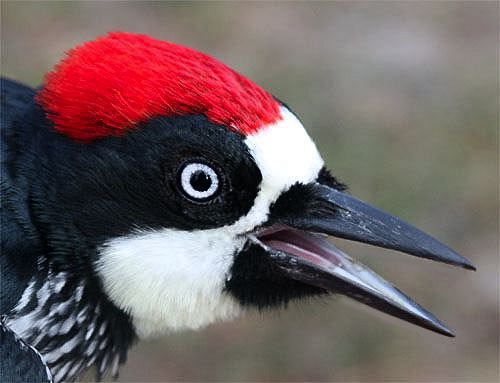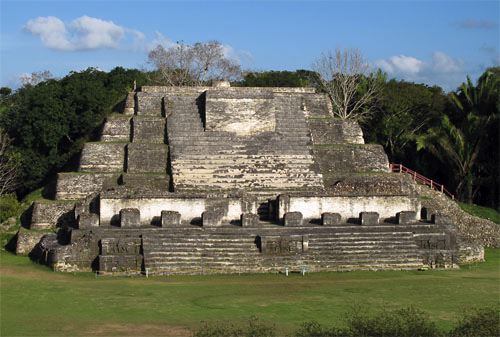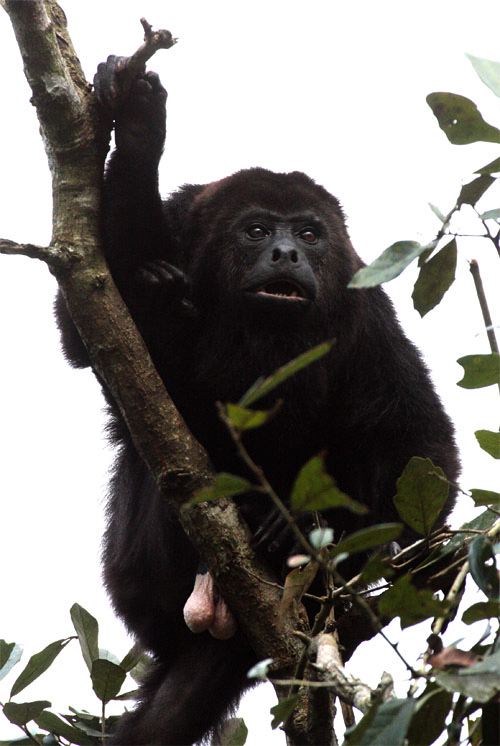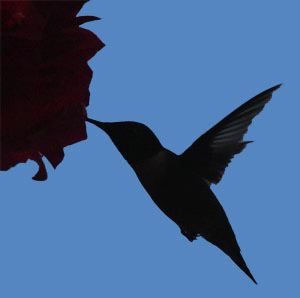|
|
|||
|
(Back to Preceding Week; on to Next Week) |
|
COSTA RICA, NICARAGUA, 'Way back in December 2003 we were invited to speak at the annual conference of the Florida Association of Science Teachers (FAST). Our topic was Operation RubyThroat: The Hummingbird Project Debbie (below right) arranged a four-day February 2004 visit to Holbrook's Selva Verde Lodge to acquaint us with Costa Rica travel, culture, and ecology and then got down to organizing--with help from in-country coordinator Paulo Valerio--our first Neotropical hummingbird expeditions.
Beginning in late January 2011 Bill Hilton Jr. and Ernesto Carman Jr. will assemble a 12-person Operation RubyThroat group in tried-and-true Costa Rica and then go on for the first time to work with a second crew at two cloud forest study sites in Nicaragua. From there we'll travel to meet a new team in central Guatemala--also a first--and end up with a fourth group watching and banding northbound hummers in Belize in early March. Expeditions will be nine days each with two days between; Days 1 & 9 are travel days (fly in, fly out); Days 2-4 and 6-8 are field study days; and Day 5 in the middle is either a rest day, an excursion day to local points of interest, or a travel day--depending on the expedition.
All text, maps & photos © Hilton Pond Center On work days we'll be in the field from about 6:30 a.m. until noon, running traps and mist nets (above), capturing and banding hummingbirds and other Neotropical migrant birds, and making observations about tropical flowers on which hummers are feeding. Afternoons are generally free for folks to explore local habitats on their own, while evenings are devoted to instructional activities and/or informal presentations by group members. There's usually an optional night walk to experience the wonders of a tropical forest after dark.
All text, maps & photos © Hilton Pond Center Expeditions include at least one half-day afternoon field trip to significant cultural or natural history sites and ample day-to-day opportunities for recreation, nature watching, and photography. Past participants (Alpha Niners, above) have been folks in good health, ages 18 to 80. You need not be an expert birder or naturalist to participate; we'll teach you everything you need to know to help with hummingbird studies.
All text, maps & photos © Hilton Pond Center Below you'll find highlights of our four upcoming Operation RubyThroat hummingbird expeditions to the Neotropics (also see map above). Every trip in 2011 is different--you can sign up for more than one (at a discount!)--so please read through all the descriptions and select those that suit your interests and schedule. (Don't forget to explore the links to day-by-day itineraries for each expedition.) We guarantee you'll enjoy participating and your help will be invaluable as we expand and intensify our studies of Ruby-throated Hummingbirds on their Central American wintering grounds.
All text, maps & photos © Hilton Pond Center - COSTA RICA - Our expert guide Ernesto Carman Jr. discovered almost a decade ago that many of Costa Rica's wintering Ruby-throated Hummingbirds concentrate in commercial Aloe Vera plantations (above) in Guanacaste, a Pacific Coast province much less humid than the rest of the country. Since 2004 those aloe fields have been our primary midwinter study sites in Central America. For 2011 we fly into Liberia and will have different lodging than in the past; instead of staying up at Buena Vista Lodge--which required a one-hour bus ride each morning to get to our study sites--we'll be based at El Sitio Best Western Hotel on the outskirts of Liberia.
All text, maps & photos © Hilton Pond Center Our lodging (with air conditioning and guaranteed hot showers--plus a big outdoor pool) will be much more accessible to various aloe plantations and will allow more leisurely afternoon field trips to: Santa Rosa National Park (the largest remnant tropical dry forest in Central America) and Junquillal Beach (on the Pacific Ocean, above); local freshwater shrimp farms (with waterfowl and wading birds such as Wood Storks, below); and a day trip to Rincón de la Vieja National Park (one of Costa Rica's most diverse locales, complete with wildlife, waterfalls, and volcanic springs.)
All text, maps & photos © Hilton Pond Center Each morning we'll visit an aloe field to deploy mist nets. We'll surely catch our target species--Ruby-throated Hummingbirds--but are likely to snare all sorts of other resident and migrant birds such as colorful Long-tailed Manakins (male, below). Guanacaste weather in late January is warm but with low humidity; our field sites require some walking over mostly level but sometimes rocky ground.
All text, maps & photos © Hilton Pond Center Your trip fee for Costa Rica includes food, lodging (double occupancy), all in-country travel, instructional activities, and two half-day field trips. Air travel, departure tax, and gratuities are extra. Costa Rica land cost is $1,799; a portion is tax-deductible in support of Operation RubyThroat. See below for a link to our Costa Rica 2011
All text, maps & photos © Hilton Pond Center - NICARAGUA - Nicaragua brings a new twist to our Neotropical hummingbird expeditions in that during the nine-day trip we'll be staying at higher altitude within an ethereal, almost mystical cloud forest (above). At 4,300-foot elevation this habitat is very different from our dry forest sites in Costa Rica and Guatemala or our sea-level locale in Belize.
All text, maps & photos © Hilton Pond Center After flying into Managua we'll take an air-conditional bus ride through tropical diverse Nicaraguan landscapes to El Jaguar Cloud Forest Reserve, a 240-acre private mixed-use property operated by environmentalist-entrepreneurs Lili and Georges Duriaux–Chavarría. El Jaguar includes an established banding station and an organic shade-grown coffee farm where visitors can learn about environmentally friendly farming practices and sample local brews.
All text, maps & photos © Hilton Pond Center El Jaguar's well-maintained walking trails make it easy to observe local flora and fauna, including 280 bird species--with 20 kinds of resident hummingbirds, any of which we might capture. There's also a diverse assemblage of insect life from beetles to butterflies (above) . . .
All text, maps & photos © Hilton Pond Center . . . and even a population of Hoffman's Two-toed Sloths (above). In all, there are 50 mammal species on the reserve--many of them nocturnal.
All text, maps & photos © Hilton Pond Center Our Nicaraguan study site is more remote and a bit more strenuous than our others in Central America, but that's all part of the adventure. El Jaguar has double-occupancy cabins and private hot-water baths--plus a group dining room with fresh fruit, meats, and vegetables at every meal.
All text, maps & photos © Hilton Pond Center At El Jaguar we'll simply walk into nearby forest after breakfast and spend morning hours running mist nets to capture Ruby-throated Hummingbirds. We expect to catch lots of other migrant and resident bird species, perhaps even a Crimson-collared Tanager (male above). February weather in the Nicaraguan cloud forest--as might be expected--can be warm and muggy; it can also get chilly, especially at night. El Jaguar will require some exertion on hilly terrain, but the site offers unusual opportunities for intimate looks at breathtaking habitats and tropical plants and animals not seen at many tourist locales.
All text, maps & photos © Hilton Pond Center Your trip fee for Nicaragua includes food, lodging (double occupancy), all in-country travel, instructional activities, and two half-day field trips (the historic town of San Rafael del Norte, above, and Selva Negra and its Three-wattled Bellbirds, below). Air travel, departure tax, and gratuities are extra. Nicaragua land cost is $1,799; a portion is tax-deductible in support of Operation RubyThroat.
All text, maps & photos © Hilton Pond Center See below for a link to our Nicaragua 2011
All text, maps & photos © Hilton Pond Center - GUATEMALA - We're going to Guatemala for the first time in 2011 because the owner of the big aloe plantation in Costa Rica personally invited us to visit Guastatoya--where he operates another aloe farm apparently attractive to Ruby-throated Hummingbirds. We fly past towering active volcanoes (above) on our way into Guatemala City; from there we'll travel to our lodging at Hotel Casa Guastatoya, with air conditioned rooms, restaurant, and outdoor pool.
All text & photos © Hilton Pond Center The hotel is on the central park in the town of Guastatoya, about a 20-minute bus ride from our study site among the aloe (above). On field days we'll spend mornings at the site running mist nets and monitoring and banding Ruby-throated Hummingbirds.
All text & photos © Hilton Pond Center With mist nets one never knows what might get caught, so we anticipate a wide variety of resident and migratory species in-the-hand--including the male Painted Bunting (above). It will be most interesting to compare our results in the Guatemalan Aloe Vera plantation with what we have found in past years among the aloe in Costa Rica.
All text & photos © Hilton Pond Center During the Guatemala expedition we'll take a mid-week overnight field trip by bus to Coban, about two hours northwest. This excursion will allow us to get out of town and into a Guatemalan cloud forest at Biotopo Del Quetzal (above). There we have very good chances of seeing a local population of Resplendent Quetzals, Guatemala's highly sought-after national bird. February weather in the Guastatoya aloe plantation is warm with moderate humidity; field work will involve moderately strenuous walking over partly hilly terrain.
All text, maps & photos © Hilton Pond Center Your trip fee for Guatemala includes food, lodging (double occupancy), all in-country travel, instructional activities, the overnight trip to Coban, and two half-day field trips (one to Guatemala City and the other to historical sites such as the ornate cathedral at San Cristobal, above). Air travel, departure tax, and gratuities are extra. Guatemala land cost is $1,599; a portion is tax-deductible in support of Operation RubyThroat. See below for a link to our Guatemala 2011
All text, maps & photos © Hilton Pond Center - BELIZE - Last year's first expedition to Crooked Tree--a sanctuary monitored by Belize Audubon Society--was a true success; we expect more of the same in 2011. After flying into Belize City we go to Bird's Eye View Lodge, where we'll be based for the week. From the Lodge we can watch spectacular sunrises across a freshwater lagoon (above) and take a slow boat for up-close looks at congregating water birds such as the five-foot-tall Jabiru stork (below, center).
All text, maps & photos © Hilton Pond Center The Lodge offers air conditioned rooms, fine dining in Creole style, and exceptionally friendly hospitality. Nearby trails allow lots of opportunities for birding and photography during afternoon free time.
All text, maps & photos © Hilton Pond Center Each morning in Belize we'll take a short van ride to run mist nets in nearby plantations and secondary forest, where flowering Cashew trees attract Ruby-throated Hummingbirds getting ready to migrate north. Since the nets are non-selective, one never knows what we might catch--perhaps a male Acorn Woodpecker (above) with eye-popping bright red, black, and white plumage. Some days we'll also work at the Lodge, capturing, banding, and releasing ruby-throats in traps we set up in an adjoining garden. Belize weather in March is usually pleasant, but some days will be warm and humid; the field sites are level and require minimal walking.
All text, maps & photos © Hilton Pond Center Your trip fee for Belize includes food, lodging (double occupancy), all in-country travel, instructional activities, and two half-day field trips (one to the ancient Mayan city of Altun Ha, above, and the other to view animals such as Black Howler Monkeys in natural exhibits at the Belize Zoo, below). Air travel, departure tax, and gratuities are extra. Belize land cost is $2,199; a portion is tax-deductible in support of Operation RubyThroat.
All text, maps & photos © Hilton Pond Center See below for a link to our Belize 2011 FOLLOW THE HUMMINGBIRDS NORTH™ For more details and a day-by-day itinerary and map for each of next year's four Operation RubyThroat expeditions, please use the links below to "Follow the Hummingbirds North." We anticipate all our trips will fill quickly, so you'll want to contact Holbrook Travel's Debbie Sturdivant as soon as possible to guarantee a slot. Otherwise you may have to spend the long, cold, dark winter of 2011 just dreaming about hummingbirds when you could be watching and catching and releasing them down in the warm, sunny, exotic Central American tropics. Week 1: COSTA RICA (29 Jan-6 Feb; $1,799) Prices do not include air fare. A portion of your fees is tax-deductible in support of Operation RubyThroat--plus each trip is discounted $100 if you sign up for more than one.
All text, maps & photos © Hilton Pond Center
|

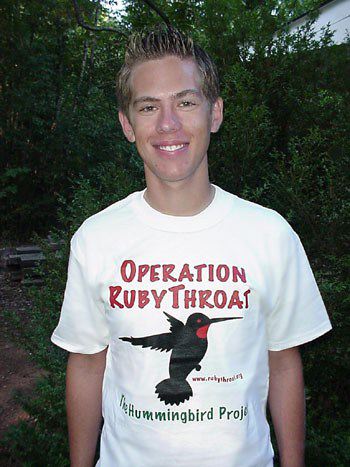 and how classroom educators and their students could help the cause of hummingbird science by making schoolyard hummer observations and submitting data on-line. To promote the project at FAST we wore one of our spiffy original Operation RubyThroat T-shirts (archival photo of son Garry at right). As we walked through the expansive vendor area, a woman in one of the booths nearly tackled us to ask if we were actually involved with the hummingbird project. We admitted we were and learned the woman was Debbie Sturdivant, specialty travel consultant with Holbrook Travel in Gainesville. Debbie, not one to mince words,
and how classroom educators and their students could help the cause of hummingbird science by making schoolyard hummer observations and submitting data on-line. To promote the project at FAST we wore one of our spiffy original Operation RubyThroat T-shirts (archival photo of son Garry at right). As we walked through the expansive vendor area, a woman in one of the booths nearly tackled us to ask if we were actually involved with the hummingbird project. We admitted we were and learned the woman was Debbie Sturdivant, specialty travel consultant with Holbrook Travel in Gainesville. Debbie, not one to mince words,  cut to the chase and posed a tantalizing question: "How would you like to lead a hummingbird expedition to Costa Rica?" It required no twisting of arms to get an affirmative response and just like that an exciting new phase began for Hilton Pond Center's on-going study of Ruby-throated Hummingbirds.
cut to the chase and posed a tantalizing question: "How would you like to lead a hummingbird expedition to Costa Rica?" It required no twisting of arms to get an affirmative response and just like that an exciting new phase began for Hilton Pond Center's on-going study of Ruby-throated Hummingbirds.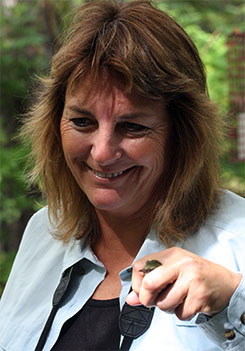 We took two groups of citizen scientists in December 2004 and January 2005--classroom teachers, birdwatchers, retired folks, and general hummingbird enthusiasts--and with expert guide Ernesto Carman Jr. started the first systematic banding study of Ruby-throated Hummingbirds in Central America. Since then we've led a total of ten Costa Rica research expeditions (banding 657 ruby-throats) and one this past March to Belize (where we banded another 54). Through Operation RubyThroat we've also taken independent trips to Guatemala (57 RTHU) and El Salvador (two banded during a one-day workshop), so our Neotropical hummer studies are coming along quite nicely. As we are prone to say, however, "We Still Want More"--which is why for 2011 we're trying something new: Four back-to-back-to-back-to-back hummingbird expeditions to Costa Rica, Nicaragua, Guatemala, and Belize. We're calling the initiative . . . .
We took two groups of citizen scientists in December 2004 and January 2005--classroom teachers, birdwatchers, retired folks, and general hummingbird enthusiasts--and with expert guide Ernesto Carman Jr. started the first systematic banding study of Ruby-throated Hummingbirds in Central America. Since then we've led a total of ten Costa Rica research expeditions (banding 657 ruby-throats) and one this past March to Belize (where we banded another 54). Through Operation RubyThroat we've also taken independent trips to Guatemala (57 RTHU) and El Salvador (two banded during a one-day workshop), so our Neotropical hummer studies are coming along quite nicely. As we are prone to say, however, "We Still Want More"--which is why for 2011 we're trying something new: Four back-to-back-to-back-to-back hummingbird expeditions to Costa Rica, Nicaragua, Guatemala, and Belize. We're calling the initiative . . . .
